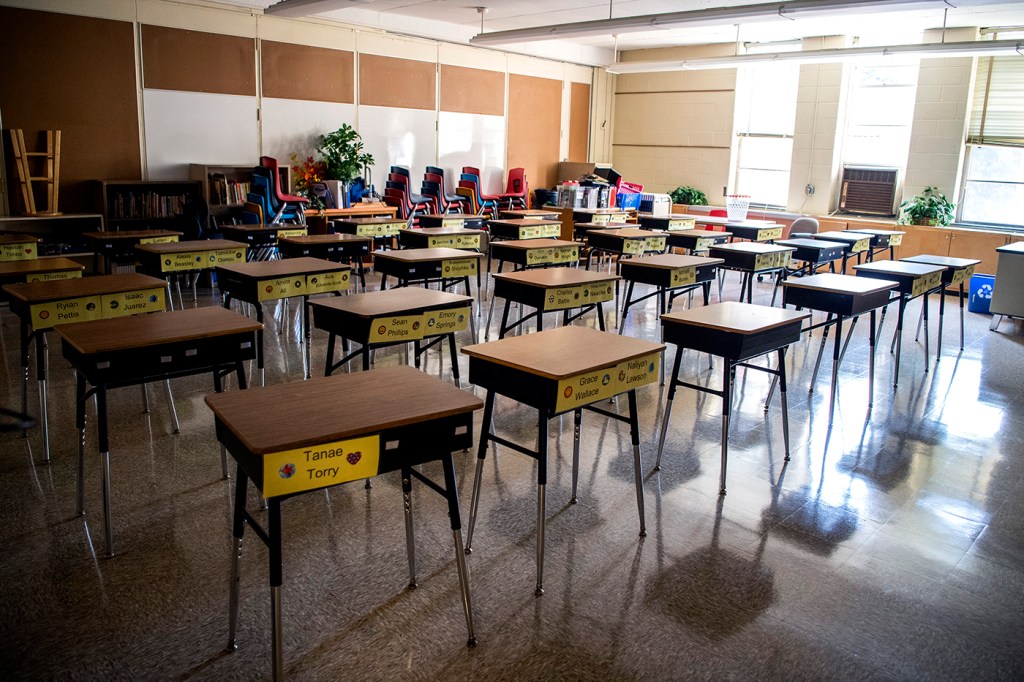Closed schools could be putting children at risk during the COVID-19 pandemic

Lockdown measures intended to keep people safe from COVID-19 in the United States may have put some schoolchildren in danger, says Margo Lindauer, director of the Domestic Violence Institute at Northeastern. But one wouldn’t know it from the decline in reported cases of child abuse and neglect.
In reality, there’s a higher likelihood that child abuse and neglect have persisted or increased during the pandemic, Lindauer says. But without access to the customary channels of communication—such as schools and doctor’s offices—these cases have largely gone unreported.

Margo Lindauer is an associate clinical professor of law and director of the Domestic Violence Institute at the Northeastern University School of Law. Photo by Ruby Wallau/Northeastern University
“What the data shows is that many child abuse and neglect reports come in through school; teachers, paraprofessionals, and nurses are mandated reporters,” says Lindauer, who is an associate clinical professor of law at Northeastern. “In a non-pandemic world, [if] kids come in with a bruise, or they haven’t been fed or bathed, or they have consistent injuries or pain, that potentially could be reported to a child welfare agency.”
She notes that a majority of these reports also tend to be made during visits with pediatricians and primary care doctors. But the pandemic has put a pause on those appointments, too—and has also caused children to miss their immunizations.
Now, seven months into the pandemic, Lindauer worries that the closure of schools, along with the added stress of balancing work, child care, and distance learning, has led to a rise in child abuse. And it’s little wonder: People have spent more time inside their homes, some have lost their jobs, and some have contracted the virus.
“All of those factors together are causing a perfect storm of increased rates of violence and decreased reporting of child abuse,” she says.
Investing in social services or organizations that encourage children to socialize safely and commune outdoors with other children and adults is key to protecting children, says Lindauer.
But even more crucial is reopening schools. To alleviate the harmful effects of distance learning and isolation, Lindauer says, schools should consider holding classes outdoors or in classrooms with reduced density. Adopting a staggered school schedule could also produce positive outcomes.
“The detrimental impacts of isolation and potential exposure to abuse, neglect, and food insecurity in many instances is worse than figuring out safe ways to get kids, at least temporarily or periodically, back in the classroom,” she says. “The longer the pandemic goes on, the worse it’s going to get.”
In a paper published recently in the New England Journal of Medicine ahead of October’s Domestic Violence Awareness Month, Lindauer and her colleagues claim that the pandemic has widened existing inequities in people’s access to social services—making it harder for victims of domestic violence to escape dangerous situations.
“When you think about domestic violence in isolation as the singular issue, you’re forgetting all of the other factors that are leading not to the violence, per se, but to the challenges in seeking safety,” she says.
Those factors often include economic mobility or access to credit. Transportation, lack of income, and the inability to get a job or find child care are additional barriers. Lindauer says that consideration should also be given to mental health and substance abuse issues.
In response to the challenges compounded by the pandemic, earlier this year Lindauer and her colleagues at the NULawLab innovation hub launched the COVID Rapid Response Project. As part of that effort, they created a mobile application that allows victims to safely and securely document instances of abuse. For the second phase of the project, Lindauer and her colleagues raised money for emergency housing for four families.
The project has been successful, says Lindauer, but the process of working with the courts has illuminated further challenges facing abuse victims. Although courts are set up to operate remotely, Lindauer says some still require plaintiffs to appear in person, placing a burden on people with children and no access to child care. And restrictions on courthouse density prevent accusers from bringing their support networks along to court hearings.
“If you’re having to face your abuser in court and you don’t have either the commotion of a busy courtroom or the emotional support of friends and family, that could be very difficult,” says Lindauer.
The COVID-19 pandemic has revealed how much work needs to be done to ensure that children and others who experience abuse can continue to access support, refuge, and medical care—before the next public health disaster hits, Lindauer says.
For media inquiries, please contact media@northeastern.edu.





